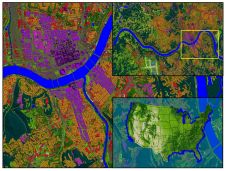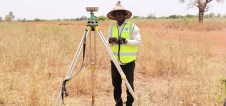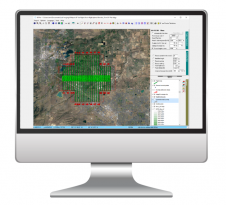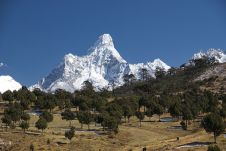Immense Help to all Stakeholders
188金宝搏特邀Gim International.面试Dr Brig. Siva Kumar, Head Natural Resource Data Management System, Govt. of India
2005年5月19日印度approv的联合内阁ed within the framework of establishing a National Spatial Data Infrastructure (NSDI) a New National Map Policy. This involves production and dissemination of two kinds of analogue and digital maps: the first, to be produced and disseminated by Survey of India/Department of Science and Technology and open to everyone, is the Open Series Maps (OSM). The Ministry of Defence will determine the use of the second kind, Defence Series Maps (DSMs). We asked this month’s interviewee, Dr Brig. Siva Kumar, to elaborate upon the vision, implementation and status of NSDI for India.
2005年5月19日印度approv的联合内阁ed within the framework of establishing a National Spatial Data Infrastructure (NSDI) a New National Map Policy. This involves production and dissemination of two kinds of analogue and digital maps: the first, to be produced and disseminated by Survey of India/Department of Science and Technology and open to everyone, is the Open Series Maps (OSM). The Ministry of Defence will determine the use of the second kind, Defence Series Maps (DSMs). We asked this month’s interviewee, Dr Brig. Siva Kumar, to elaborate upon the vision, implementation and status of NSDI for India.
印度NSDI背后的概念和愿景是什么?
NSDI is an information infrastructure that envisages providing spatial data to collate standardised information for many identified and selective sources following the standards, protocols and procedures accepted by the stakeholders. NSDI will also promote the generation of value-added data for diverse user applications, and for transaction of spatial data business between user bodies within an open-access public domain. In a nutshell, it will create a reliable and supportive infrastructure that will help in access to geographical data, using standard practice, protocols and specifications. The vision of NSDI endeavours to create a national infrastructure for the availability of and access to geospatial data and use of this infrastructure at community, local, state, regional and national levels for sustainable development.
What is the present status of NSDI development and implementation?
Government of India constituted a Task Force in the year 2000 to evolve NSDI. The Task Force completed its job and submitted its report in May 2006. Subsequently, the Cabinet approved creation of NSDI and constituted a National Spatial Data Committee and an Executive Committee with a lean secretariat to assist the two committees. The process of conversion of data from analogue to digital by various organisations has commenced, and many of these are ready with their digital datasets. DST is in the process of acquiring the requisite hardware and software for a geo-portal.
Will the present policy framework enable availability of spatial data from all government departments, and what will be the pricing structure?
Besides NSDI, Government of India has also brought in changes in the map policy, and National Map Policy 2005 enables the user to access data of all parts of the country. Thus it provides an opportunity for the user community to access maps data and other geospatial data. However, NSDI will handle only unclassified data, and if the data becomes classified it is to be handled in the manner prescribed. With respect to pricing structure: NSDI is not a profit-making body. It is only a mechanism for disseminating data from various sources. It will provide data to the stakeholders, who will price their products. NSDI may collect a small transaction fee to cover its operational expenses.
What are procedures for sharing classified data through NSDI?
Data that is classified and has security implications will not be part of the activities of NSDI.
What about the costs?
The cost of NSDI will presently be met from the budget of the Department of Science and Technology and Survey of India. The total cost involved is not much and the secretariat is lean, consisting of only ten persons. However, public-private partnership may be explored for the generation of data and products and providing services and solutions.
新地图策略如何支持NSDI愿景?
本国家地图策略2005还允许直接传播数据。这些政策必须进行微调,以跟上技术进步而不是通过计算机网络和网络服务。但是,用户可以访问元数据,框架数据和服务等。
How has the formalisation of policy on NSDI by the Govt. of India impacted and speeded up NSDI development?
以政府决议的形式传达的内阁的批准正式认识到对NSDI的需求,并为其快速实施提供必要的工具。正在解决元数据,标准,转换和互操作性的问题,并且在将印度调查数据转换为GML(地理标记语言)方面取得了发展。这将使数据可视化,使用Internet Explorer在Web上具有次要GIS查询,从而节省用户购买昂贵的软件的支出。在完成硬件和软件采购后,将连接各种利益相关者节点,这可能需要三到六个月。
Who do you see as users of NSDI?
The users of NSDI will constitute a broad spectrum, right from the common man to various departments of the Government of India. You might say that the understanding of spatial data among the common masses is minimal in India, and for this NSDI has a programme of outreach and efforts are also being made to educate people through seminars and conferences being held all over the country. In addition, a multimedia kit has been prepared for display at various locations. Furthermore, developments such as Google Earth and Microsoft Virtual Earth will enhance the requirement for vector geospatial data.
许多用户对数据不感兴趣,但在最终输出中。你如何应对这一点?
NSDI的最终目标是提供数据。用户可以简单地登录系统并利用可用的数据,而无需购买任何昂贵的软件。对应用程序开发有一个重大推动力。它将与下载数据的传统实践不同,并使用昂贵的软件来导出解决方案。用户可以登录NSDI,下载数据和软件,使用计算设施和应用程序模型来派生解决方案。他只会取出解决方案而不是数据。这种方式,他使用地理空间数据找到解决方案的支付更少。
How does NSDI plan to collaborate with similar initiatives elsewhere in the world?
We are aware of the efforts in other parts of the world and we have been providing our expertise to the countries in this region. Except for Canadian Geo-connections, we have not found any working model. We have developed a prototype geo-portal in collaboration with natural Resources Canada in project mode.
When will the NSDI have achieved its goals?
布丁的证据是在吃饭中。我们确信利用NSDI的服务将是当代的,并将受到所有利益相关者的赞赏,他将在加快决策过程方面找到巨大的帮助.u

























